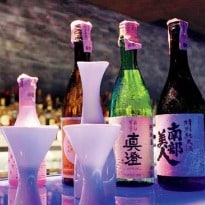Can anything made from fermented rice be good? Doesn't sound tempting, we thought. But everyone who's sipped it can't stop praising Sake to high heaven. So we gave Japan's national drink a shot. And then two. More shots followed. We are converts. We swear by Sake. Here's why, writes Dhiman Chattopadhyay."Can I have a sake to go with the dim sums please?" A simple request you would think. But that one question exposes my ignorance about the national drink of perhaps the world's hardest working and most innovative race. And ultimately sends me home a wiser man."Would you like a Nigori, a Honjozo or a pure Junmai?" asks Chinmay Barve, sommelier at Hakkasan, the Indian branch of the Michelin star restaurant located in Bandra.
Picture: Sake (pronounced sah-keh) refers to any alcohol in Japan, though in the west, it commonly refers only to Japanese rice wine or Nihonshu."Err, Honjozo," I reply, my mind working quickly. Sounds like a nice name to pronounce, is second of the three varietals (there is safety in being in the middle) and the menu mentions it as a light sake. But it seems I still haven't cracked it. "Sir, would you like it cold, or warmed?" asks Barve. Warm booze? I opt for chilled.In a few minutes the yummy dimsums are brought to the table, followed by what I can only call a ritual. One waiter brings the sake bottle (the brand is called Masumi Tokusen), two crystal-clear sake cups and a rounded carafe to the table. The carafe, I notice, has a hole on one side, which is stuffed with crushed ice. But the ice never touches the sake. "Once we put the sake into the carafe, the ice ensures the container remains cold. That way you can sip the sake cold," I am informed. Most sake varieties go well with dim sums. Pics/Bipin KokateThe sake cup is tiny, like a round shot glass. I sip. It's flowery, slightly sweet with an unmistakable smell of rice. I pick up a dim sum as daintily as my chopstick lessons allow me to. Divine.So I corner Barve and Hakkasan's GM, Ketan Gohel, to learn more about Sake. Sake (pronounced sah-keh) refers to any alcohol in Japan, though in the west commonly it refers only to Japanese rice wine or Nihonshu. Sake is served in a small, usually ceramic carafe called a tokkuri. It's usually bulbous with a narrow neck, but there are other types, such as katakuchi, which looks somewhat like a tea kettle. Some regular sake such as honjozoshu (or Honjozo) and shunmaishu are usually warmed to room temperature, while ginjoshu and namazake (sake which has not been pasteurised) are chilled.
Nigori or Cloudy Sake
Looks cute, is my first thought when I see the small bottle of Sayuri Nigori (Sayuri being a brand of Nigori). It's half the size of a regular sake bottle. "There is substantial rice yeast sediment in the bottle. So you have to shake this before serving. The 'cloudy' tag comes because of the sediment," Barve says. I sip carefully. Nigori has a creamy texture, obviously from the fermented rice. This is always to be sipped chilled. You can almost feel the particles. This is a full bodied and sweet sake.Goes with: If you want to have this with your dinner, go ahead and order a mushroom claypot, says Barve or if you are a non-vegetarian, then ask for steamed rawas with chilly sauce or a black pepper tenderloin. "It cuts the spice and acts as a palette cleanser," he explains. The good news: this is also an ideal sake to enjoy on a breezy evening on your balcony. Sake, sea and you...and no you don't need mushrooms or rawas. Just nuts will do.
HonjozoI know this one, I smile. But hold on. I learn how it's made. During the fermentation process, rice alcohol is induced or added to the process to stop the fermentation artificially to make this a light-bodied drink. Honjozo can be sipped either chilled or warm.Goes with: If you are having it warm, pair it with Hakka braised pork belly or slightly spicy food. But as a cold drink, this blends perfectly with a crispy duck salad or dim sum. Masumi Tokusen is the brand of Honjozo available at Hakkasan.
JunmaiThis is the pure form of rice sake. Masumi Okuden Kantsukuru is the brand on offer (if you can pronounce this, you have won half the battle). Trust me, this one is not for novices."The fermentation in a pure rice sake is natural. It stops on its own. It's bottled after filtering. So this is a very full-bodied wine. But it is well-rounded and easy to drink," assures Barve. But while the Masumi Okuden Kantsukuru that I sip is indeed smooth, the Nanbu bijin tokubetsu junmai, Gohel tells me with conviction, is "pretty sharp.""Only an evolved sake drinker should try this warm. As a chilled drink it's easy but it's far more potent when warm, with the alcohol content coming to the fore," I am told.Goes with: The Japs love their seafood and so, this one too goes with grilled fish or stir-fried asparagus and lotus root, if sipped warm. Chilled, it's a perfect mate for a salad.
Serve with careBut if drinking sake is an art, the Japanese have got the serving bit down to a science. Sake is always served in a carafe and sake cups. For chilled sake, it's a glass cup and carafe while for warm sake it's a ceramic carafe (shaped more like a narrow-necked flower vase) and ceramic cups, which have a definite stem.And here's what: If you want to sip it chilled, take it out of the fridge and serve within five minutes, so that the temperature ranges between 6 to 8 degrees Celsius when served.For warm sake, the bottle should be kept out, preferably in a warm bowl (water bath is the official term) and slowly heated, over five to eight minutes, to a temperature not more than 55 to 60 degree Celsius. Any more, and the alcohol will begin to evaporate and as Gohel says, "you might as well be sipping warm water."Which is why sake is served in such small cups. "You wouldn't want the temperature to vary as you sip the sake, right? So the chilled sake is kept in a carafe with crushed ice keeping the bottle cold, while warm sake is kept in a warm bath as you pour about five sips at a time," smiles Barve.But why does the same variety of sake taste so different in different restaurants? "Don't different kinds of merlot taste vastly different too? Australian reds are much more full-bodies than Indian reds for example," explains Barve, adding: "similarly with Sake, it's about fermentation and also about how well polished the rice is. The more well-polished the rice, the more expensive and exquisite the sake."Sake drunk -- check. Lessons learnt -- check. Job done -- check. We hit the road, happy that we can impress all those who care to listen to us, with our improved knowledge of Sake.
Picture: Sake (pronounced sah-keh) refers to any alcohol in Japan, though in the west, it commonly refers only to Japanese rice wine or Nihonshu."Err, Honjozo," I reply, my mind working quickly. Sounds like a nice name to pronounce, is second of the three varietals (there is safety in being in the middle) and the menu mentions it as a light sake. But it seems I still haven't cracked it. "Sir, would you like it cold, or warmed?" asks Barve. Warm booze? I opt for chilled.In a few minutes the yummy dimsums are brought to the table, followed by what I can only call a ritual. One waiter brings the sake bottle (the brand is called Masumi Tokusen), two crystal-clear sake cups and a rounded carafe to the table. The carafe, I notice, has a hole on one side, which is stuffed with crushed ice. But the ice never touches the sake. "Once we put the sake into the carafe, the ice ensures the container remains cold. That way you can sip the sake cold," I am informed. Most sake varieties go well with dim sums. Pics/Bipin KokateThe sake cup is tiny, like a round shot glass. I sip. It's flowery, slightly sweet with an unmistakable smell of rice. I pick up a dim sum as daintily as my chopstick lessons allow me to. Divine.So I corner Barve and Hakkasan's GM, Ketan Gohel, to learn more about Sake. Sake (pronounced sah-keh) refers to any alcohol in Japan, though in the west commonly it refers only to Japanese rice wine or Nihonshu. Sake is served in a small, usually ceramic carafe called a tokkuri. It's usually bulbous with a narrow neck, but there are other types, such as katakuchi, which looks somewhat like a tea kettle. Some regular sake such as honjozoshu (or Honjozo) and shunmaishu are usually warmed to room temperature, while ginjoshu and namazake (sake which has not been pasteurised) are chilled.
Nigori or Cloudy Sake
Looks cute, is my first thought when I see the small bottle of Sayuri Nigori (Sayuri being a brand of Nigori). It's half the size of a regular sake bottle. "There is substantial rice yeast sediment in the bottle. So you have to shake this before serving. The 'cloudy' tag comes because of the sediment," Barve says. I sip carefully. Nigori has a creamy texture, obviously from the fermented rice. This is always to be sipped chilled. You can almost feel the particles. This is a full bodied and sweet sake.Goes with: If you want to have this with your dinner, go ahead and order a mushroom claypot, says Barve or if you are a non-vegetarian, then ask for steamed rawas with chilly sauce or a black pepper tenderloin. "It cuts the spice and acts as a palette cleanser," he explains. The good news: this is also an ideal sake to enjoy on a breezy evening on your balcony. Sake, sea and you...and no you don't need mushrooms or rawas. Just nuts will do.
HonjozoI know this one, I smile. But hold on. I learn how it's made. During the fermentation process, rice alcohol is induced or added to the process to stop the fermentation artificially to make this a light-bodied drink. Honjozo can be sipped either chilled or warm.Goes with: If you are having it warm, pair it with Hakka braised pork belly or slightly spicy food. But as a cold drink, this blends perfectly with a crispy duck salad or dim sum. Masumi Tokusen is the brand of Honjozo available at Hakkasan.
JunmaiThis is the pure form of rice sake. Masumi Okuden Kantsukuru is the brand on offer (if you can pronounce this, you have won half the battle). Trust me, this one is not for novices."The fermentation in a pure rice sake is natural. It stops on its own. It's bottled after filtering. So this is a very full-bodied wine. But it is well-rounded and easy to drink," assures Barve. But while the Masumi Okuden Kantsukuru that I sip is indeed smooth, the Nanbu bijin tokubetsu junmai, Gohel tells me with conviction, is "pretty sharp.""Only an evolved sake drinker should try this warm. As a chilled drink it's easy but it's far more potent when warm, with the alcohol content coming to the fore," I am told.Goes with: The Japs love their seafood and so, this one too goes with grilled fish or stir-fried asparagus and lotus root, if sipped warm. Chilled, it's a perfect mate for a salad.
Serve with careBut if drinking sake is an art, the Japanese have got the serving bit down to a science. Sake is always served in a carafe and sake cups. For chilled sake, it's a glass cup and carafe while for warm sake it's a ceramic carafe (shaped more like a narrow-necked flower vase) and ceramic cups, which have a definite stem.And here's what: If you want to sip it chilled, take it out of the fridge and serve within five minutes, so that the temperature ranges between 6 to 8 degrees Celsius when served.For warm sake, the bottle should be kept out, preferably in a warm bowl (water bath is the official term) and slowly heated, over five to eight minutes, to a temperature not more than 55 to 60 degree Celsius. Any more, and the alcohol will begin to evaporate and as Gohel says, "you might as well be sipping warm water."Which is why sake is served in such small cups. "You wouldn't want the temperature to vary as you sip the sake, right? So the chilled sake is kept in a carafe with crushed ice keeping the bottle cold, while warm sake is kept in a warm bath as you pour about five sips at a time," smiles Barve.But why does the same variety of sake taste so different in different restaurants? "Don't different kinds of merlot taste vastly different too? Australian reds are much more full-bodies than Indian reds for example," explains Barve, adding: "similarly with Sake, it's about fermentation and also about how well polished the rice is. The more well-polished the rice, the more expensive and exquisite the sake."Sake drunk -- check. Lessons learnt -- check. Job done -- check. We hit the road, happy that we can impress all those who care to listen to us, with our improved knowledge of Sake.
Advertisement













